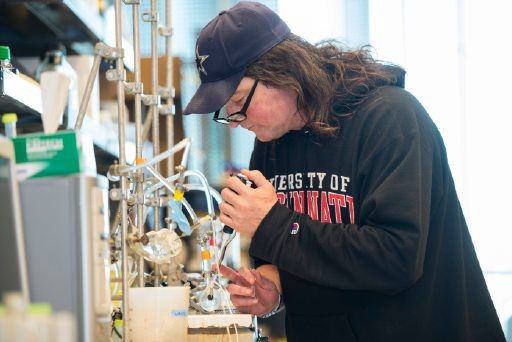
Atlanta Journal Constitution: Ointment kills antibiotic-resistant bacteria, promotes wound healing
Drug developed by UC researcher could be effective against 'superbugs'
Research at the University of Cincinnati College of Medicine may have added a weapon to hospitals’ bacteria fighting arsenal.
Using the topical drug called AB569 — a combination of acidified nitrite and ethylenediaminetetraacetic acid — promotes killing of antibiotic-resistant bacteria while enhancing the healing of wounds in a variety of burn injuries, the study found. The study was published in the journal Infection and Immunity.
The Atlanta Journal Constitution published a story on the research by Daniel Hassett, PhD, professor in the Department of Molecular Genetics, Biochemistry and Microbiology at the UC College of Medicine. Hassett patented AB569 in 2018.

Daniel Hassett, PhD, professor in the Department of Molecular Genetics, Biochemistry and Microbiology at the UC College of Medicine/Photo/Colleen Kelley/UC Creative + Brand
His research has found that AB569 kills virtually all pathogenic bacteria tested. Those bacteria are some of the most serious pathogens exhibiting multidrug resistance and enhanced virulence properties, according to the Centers for Disease Control and Prevention.
“Multidrug resistant bacteria, often called ‘superbugs,’ are an ever-burgeoning global health problem,” Hassett said. “As a result, there is a critical need to develop novel and effective antimicrobials for the prevention, treatment and eradication and healing of such wounds that are complicated by the most formidable pathogen of burn patients, known as MDR-PA. Injury severity is predominantly due to potentially lethal sepsis caused by MDR-PA.”
AB569 was first seen as a treatment for antibiotic-resistant organisms that cause pulmonary infections in patients with cystic fibrosis and chronic obstructive pulmonary disease, and many other opportunistic infections. In addition to tackling COPD and cystic fibrosis, AB569 may also be effective in addressing infections related to severe burns, urinary tract disorders, endocarditis and diabetes, Hassett said.
Hassett was also interviewed about this research by WVXU. See that coverage here.
Next Lives Here
The University of Cincinnati is classified as a Research 1 institution by the Carnegie Commission and is ranked in the National Science Foundation's Top-35 public research universities. UC's medical, graduate and undergraduate students and faculty investigate problems and innovate solutions with real-world impact. Next Lives Here.
Related Stories
Everything you need to know about scents and your hair
May 1, 2025
The University of Cincinnati's Kelly Dobos was featured in an NBC News article discussing the science behind hair fragrances and shampoos.
A farewell for the iconic Crosley Tower
May 1, 2025
The Cincinnati Business Courier reports that UC Board of Trustees approved $47.3 million for remediation and demolition of Crosley Tower. There are mixed feelings about what has been dubbed by some as the ugliest building on a U.S. college campus.
Machine learning brings new insights to cell’s role in...
April 30, 2025
Researchers led by the University of Cincinnati’s Anna Kruyer and the University of Houston’s Demetrio Labate have published research in the journal Science Advances applying object recognition technology to track changes in brain cell structure and provide new insights into how the brain responds to heroin use, withdrawal and relapse.
